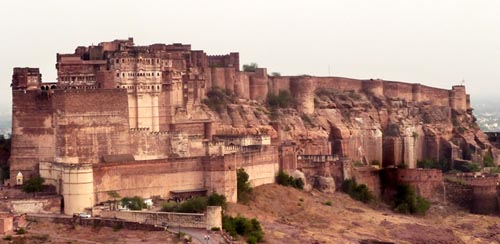Mehrengarh Fort

Information on Mehrengarh Fort (Jodhpur, Rajasthan) - History & Architecture
The Mehrangarh fort is in Jodhpur town of Rajashtan, a western state of India. It is built on a citadel which is high around 400 meters above the sea level and has a magnificent view of Jodhpur city, when viewed from the fort. It is one of the biggest forts in India. It was built by the 'Rathor's' .i.e. the rulers of western part of India in the 15th century AD. The foundation to build the fort was laid by 'Rao Jodha' in 1459 and later completed by his successors in a decade of time. To reach here it is well connected by roads, rails and airport. It's is only 985 km from 'Mumbai' the financial capital of India. From the national capital 'New Delhi it's just 587 km. Daily trains, buses and flights are well connected to Jodhpur city. Locally you have all traditional passenger crafts named 'Rikshas' and rooming around the city is possible on the Camel's Back, which is a rare experience to others living out of desert regions. One can visit here to see the magnificent structure that was built to safe guard its kingdom from invaders and wars happened in those days.
Mehrengarh Fort Architecture
The Mehrangarh Fort is built on the principles of whether temperament designs. Since it's in hot region, its architectural attributes are as such that it will be cool inside in summer and feel hot in winter. These techniques of the fort can't be seen. These techniques of temperature controlling attributes are built hidden within the building itself. More over there are vast number of windows and doors to grab wind flows and sunlight. This fort is built on a vertical rock cliff surrounded by 3.125 miles and the forts wall rises from 50 meters to 120 meters in height. Due to its elevation from ground and its large structure it is named 'Mehrangarh' which means the 'citadel for sun god'. The red sand stone structure looks pleasant in the sun shine and the fort when viewed from long distance in the night seems to be a haunting place. It is built on the Hindu principles and practiced the geographical wind pattern to allow wind inside the structure. There are lots of stone and wooden carvings in this fort which take our breath. Still no one is able to conclude how this fort is crafted in elevated areas, that to by giving traditional designs on outside the walls.
Mehrengarh Fort History
The Mehrangarh Fort has historical significance in safe guarding the Jodhpur city from foreign invaders, mainly the Muslim rulers from the west. Its fort on the citadel made many 'Rathore kings' to fight the battle by fire tanks and had a look of the city from all directions. It has noted seven large gates. This region was ruled by Rajput Clans and the Marwars. Prithviraj Chauhan is the famous king among them. The khanouj and the Moughal had always an eye on Jodhpur to bring in their territory. It has seen the ups and downs of the Rathor regime over the past 500 years.
Mehrengarh Fort Tourism Importance
The Mehrangarh Fort is a significant tourist place in Rajasthan; since the 'Rajasthan International Folk Festival' is held in the month of October, is a foreign treat in India. Here traditional music professional participate and show their talent with Indian artists. It is a retreat for art and cultural lovers. There is lot of art patterns to learn from this fort. Its day old material of ware fare, utilities and precious articles are still preserved there by archeological department of India. The fort is open to public and there is a minimal entry fee. The best time to visit Mehrangarh fort is from October to February when temperature is below 30 Degree Celsius.
- Andaman Nicobar Monuments
- Andhra Pradesh Monuments
- Assam Monuments
- Bihar Monuments
- Chhattisgarh Monuments
- New Delhi Monuments
- Goa Monuments
- Gujarat Monuments
- Haryana Monuments
- Himachal Pradesh Monuments
- Jammu and Kashmir Monuments
- Karnataka Monuments
- Kerala Monuments
- Madhya Pradesh Monuments
- Maharashtra Monuments
- Odisha Monuments
- Punjab Monuments
- Rajasthan Monuments
- Tamil Nadu Monuments
- Telangana Monuments
- Uttar Pradesh Monuments
- West Bengal Monuments